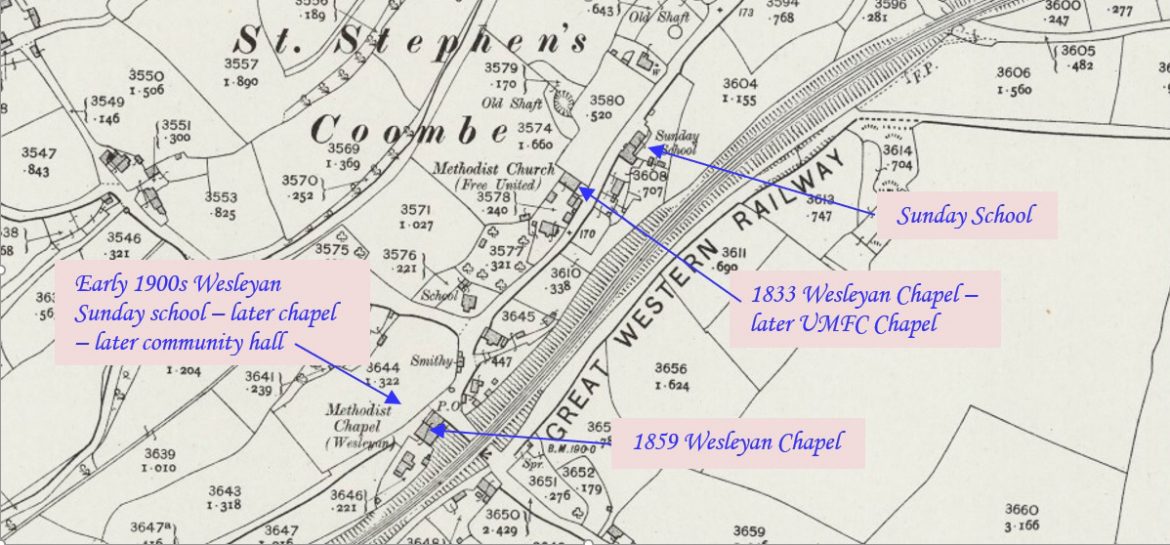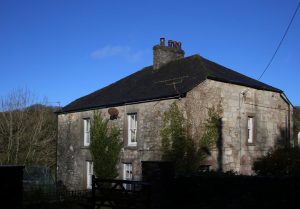Mapping Methodism – Coombe (St Stephen-in-Brannel) Wesleyan / UMFC / UM
Categories Mapping Methodism, Projects0 Comments
Coombe is approximately four miles (6 km) west of St Austell in the civil parish of St Stepen-in-Brannel. This profile of Coombe (St Stephen-in-Brannel) United Methodist Free Church has been compiled by Jo Lewis and Tony Mansell.
This building can be seen on the left driving up the high street West to East.
Formerly a United Methodist Chapel and recorded on the 1st Edition OS 1:2500 map. Now a private house. (Cornwall Council Heritage Gateway)
A Sunday school, first recorded on the 2nd Edition OS 1:2500 map, and now a private house. (Cornwall Council Heritage Gateway)
Indicated as a United Methodist Free Church on the side-by-side maps.
Indicated as a United Methodist Chapel. (http://maps.nls.uk/view/101438918 / old.maps.co.uk)
 (Photo: Jo Lewis 2021)
(Photo: Jo Lewis 2021)
Circa 1833: Built as a Wesleyan Chapel.
Probably circa 1859: Became Coombe United Methodist Free Church.
1903: Planning documents show a proposed plan for stable and trap house.
1907: The Methodist New Connexion, Bible Christians and United Methodist Free Churches amalgamated to become the United Methodist Church.
1907: Became Coombe United Methodist Chapel
 1920s: Coombe, St Stephen-in-Brannel United Methodist Tea Treat (Photo: courtesy of Malcolm Gould / China Clay History Society)
1920s: Coombe, St Stephen-in-Brannel United Methodist Tea Treat (Photo: courtesy of Malcolm Gould / China Clay History Society)
 1920s: Coombe, St Stephen-in-Brannel United Methodist Tea Treat (Photo: courtesy of Malcolm Gould / China Clay History Society)
1920s: Coombe, St Stephen-in-Brannel United Methodist Tea Treat (Photo: courtesy of Malcolm Gould / China Clay History Society)
 1920s: Coombe, St Stephen-in-Brannel United Methodist Tea Treat (Photo: courtesy of Malcolm Gould / China Clay History Society)
1920s: Coombe, St Stephen-in-Brannel United Methodist Tea Treat (Photo: courtesy of Malcolm Gould / China Clay History Society)
 1920s: Coombe, St Stephen-in-Brannel United Methodist Tea Treat (Photo: courtesy of Malcolm Gould / China Clay History Society)
1920s: Coombe, St Stephen-in-Brannel United Methodist Tea Treat (Photo: courtesy of Malcolm Gould / China Clay History Society)
 1920s: Coombe, St Stephen-in-Brannel United Methodist Tea Treat (Photo: courtesy of Malcolm Gould / China Clay History Society)
1920s: Coombe, St Stephen-in-Brannel United Methodist Tea Treat (Photo: courtesy of Malcolm Gould / China Clay History Society)
1930s: Closed and congregation joined other Coombe chapel. (David Easton, Methodist minister and historian)
Chapel and Sunday school converted into private houses. The original door arch in the chapel is bricked over but can still be seen, as can the date stone which reads 1833.
